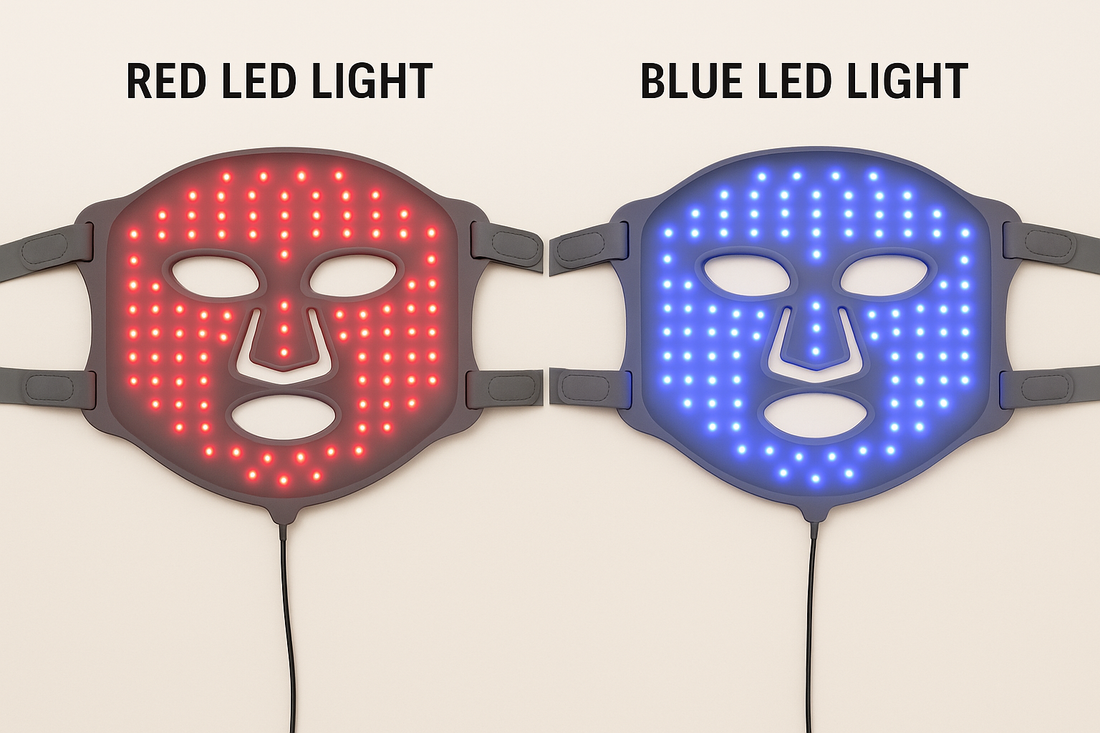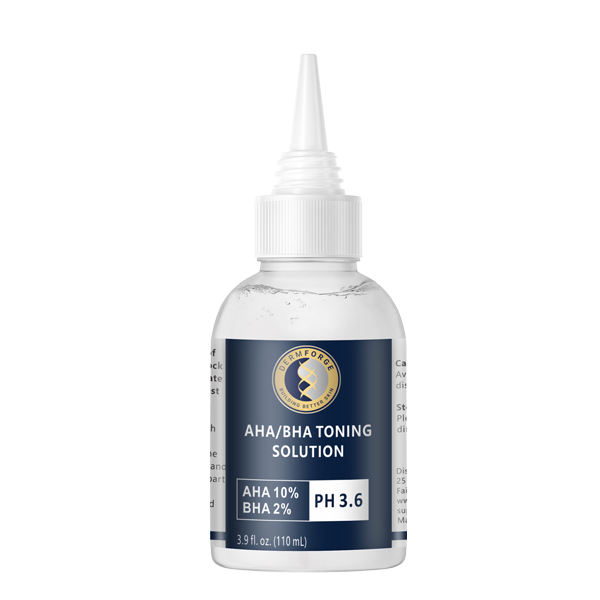LED light therapy has become a popular method for addressing various skin concerns. By using specific light wavelengths, this treatment offers non-invasive solutions for issues like acne and signs of aging. Understanding the differences between red and blue LED light therapies can help you choose the most suitable option for your skin's needs.
Red LED light therapy primarily focuses on skin rejuvenation. It penetrates deeper layers of the skin, stimulating collagen production and reducing inflammation. This process can diminish fine lines and wrinkles, resulting in a smoother, more youthful complexion. Additionally, red light therapy aids in healing damaged skin and improving overall skin tone.
On the other hand, blue LED light therapy targets acne-related issues. It works by penetrating the skin's surface to eliminate acne-causing bacteria, reducing breakouts and preventing future blemishes. Furthermore, blue light therapy helps regulate oil production, which is beneficial for individuals with oily or acne-prone skin.
When deciding between red or blue LED light therapyRedLightTherapy , consider your specific skin concerns. Red light is ideal for anti-aging and healing purposes, while blue light effectively addresses acne and oil control. Consulting with a skincare professional can provide personalized guidance tailored to your skin type and goals.
Understanding LED Light Therapy: How It Works
LED light therapy is a non-invasive treatment that uses specific light wavelengths to address various skin concerns. By emitting light at particular wavelengths, this therapy penetrates the skin to stimulate cellular processes.
Red light therapy typically utilizes wavelengths around 630 to 660 nanometers. This light penetrates deeply into the skin, reaching the dermis where it stimulates fibroblast activity. As a result, collagen and elastin production increase, leading to improved skin elasticity and a reduction in fine lines and wrinkles. Additionally, red light helps enhance blood circulation, promoting better oxygenation and nutrient delivery to skin cells.
On the other hand, blue light therapy uses wavelengths in the range of approximately 415 to 450 nanometers. This shorter wavelength targets the epidermis, effectively addressing surface-level skin issues. Blue light is known for its antibacterial properties, particularly against Propionibacterium acnes, the bacteria responsible for acne breakouts. By reducing bacterial presence and decreasing inflammation, blue light therapy can lead to clearer skin.
When considering red or blue LED light therapy, it's essential to understand their distinct benefits. Red light is often chosen for its anti-aging effects and overall skin rejuvenation. In contrast, blue light is preferred for combating acne and improving skin clarity. Some treatments combine both wavelengths to address multiple skin concerns simultaneously.
Incorporating LED light therapy into your skincare routine can be a beneficial approach to achieving healthier skin. Whether opting for red or blue LED light, understanding how each works will help you make informed decisions tailored to your skin's needs.
Benefits of Red LED Light Therapy for Skin
Red LED light therapy offers several benefits for your skin, particularly in addressing signs of aging and promoting healing. By stimulating collagen production, reducing wrinkles, and enhancing skin repair, this treatment has become a popular choice in skincare routines.
Collagen is a protein that maintains your skin's firmness and elasticity. As you age, collagen levels decrease, leading to sagging and wrinkles. Red LED light therapy penetrates deep into your skin, activating fibroblasts—the cells responsible for collagen production. This stimulation helps restore skin structure and resilience.
Additionally, increased collagen production can smooth out fine lines and wrinkles. Regular sessions of red LED light therapy may result in a more youthful and refreshed appearance.
Beyond its anti-aging effects, red LED light therapy supports skin healing. It enhances blood circulation, delivering more oxygen and nutrients to damaged tissues. This process accelerates the repair of wounds, reduces inflammation, and can improve the appearance of scars.
When considering red or blue LED light therapies, it's important to understand their distinct benefits. Red light focuses on anti-aging and healing, while blue light targets acne-causing bacteria. Choosing the appropriate therapy depends on your specific skin concerns.
Incorporating red LED light therapy into your skincare regimen can be a straightforward way to address signs of aging and promote skin health. Consistent use may lead to noticeable improvements, helping you achieve a smoother and more radiant complexion
Benefits of Blue LED Light Therapy for Skin
Blue LED light therapy offers several benefits for your skin, particularly in managing acne and controlling oil production. By targeting acne-causing bacteria and regulating sebum levels, this treatment can lead to a clearer complexion.
Acne often results from the proliferation of Propionibacterium acnes bacteria within clogged pores. Blue LED light penetrates the skin's surface to effectively reduce these bacteria, thereby decreasing inflammation and the occurrence of breakouts. Regular sessions can help diminish existing acne and prevent new blemishes from forming.
Additionally, blue light therapy has been shown to influence sebaceous glands, which are responsible for oil production. By modulating their activity, this treatment can reduce excess oil on your skin. Consequently, pores are less likely to become clogged, further minimizing the risk of acne development.
When considering red or blue LED light therapies, it's important to understand their distinct benefits. While red light is often used for its anti-aging and healing properties, blue light specifically addresses acne and oil control. Combining both treatments may provide comprehensive skin care, depending on your individual needs.
Incorporating blue LED light therapy into your skincare routine can be a practical approach to managing acne and achieving balanced skin. Consistent use may lead to noticeable improvements, helping you attain a clearer and healthier complexion.
Red vs. Blue LED Light: Key Differences
LED light therapy offers effective solutions for various skin concerns, with red and blue lights being the most commonly used wavelengths. Understanding the differences between these therapies can help you choose the best option for your skin.
Red light therapy operates at wavelengths between 630 to 670 nanometers, allowing it to penetrate deeper into the skin. This depth of penetration stimulates fibroblasts, enhancing collagen and elastin production. As a result, red light therapy effectively addresses signs of aging, such as fine lines and wrinkles, and promotes overall skin rejuvenation. Additionally, it reduces inflammation and accelerates wound healing, making it beneficial for scar reduction and improving skin texture.
In contrast, blue light therapy utilizes shorter wavelengths, approximately 415 to 495 nanometers, targeting the skin's surface. This treatment is particularly effective against acne, as it neutralizes Propionibacterium acnes, the bacteria responsible for breakouts. By reducing bacterial presence and diminishing inflammation, blue light therapy helps clear existing acne and prevent future blemishes. Furthermore, it can regulate oil production, contributing to a balanced complexion.
When deciding between red or blue LED light therapy, consider your specific skin concerns. Red light is ideal for anti-aging and healing purposes, while blue light excels in treating acne and controlling oil production. Combining both therapies can provide a comprehensive approach to skincare, addressing multiple issues simultaneously.
Incorporating the appropriate LED light therapy into your routine can lead to significant improvements in your skin's health and appearance. Understanding the distinct benefits of each type ensures you make informed choices tailored to your skincare needs.
Who Should Use Red or Blue LED Light Therapy?
LED light therapy offers effective solutions for various skin concerns, with red and blue lights being the most commonly used wavelengths. Understanding which therapy suits your skin type and condition can help you achieve optimal results.
Red light therapy is beneficial for individuals seeking anti-aging treatments and skin rejuvenation. It penetrates deeper layers of the skin, stimulating collagen and elastin production. This process helps reduce fine lines, wrinkles, and improves overall skin texture. Additionally, red light therapy can alleviate inflammation and promote healing, making it suitable for those with rosacea or sun-damaged skin. If your goal is to enhance skin elasticity and achieve a more youthful appearance, red light therapy may be appropriate.
Conversely, blue light therapy is primarily recommended for individuals with acne-prone skin. It targets the skin's surface to eliminate acne-causing bacteria, reducing breakouts and preventing future blemishes. Moreover, blue light therapy can help regulate oil production, which is beneficial for those with oily skin types. If you struggle with persistent acne or excessive oiliness, incorporating blue light therapy into your skincare routine could be advantageous.
When deciding between red or blue LED light therapy, consider your specific skin concerns and consult with a dermatologist. They can provide personalized recommendations based on your skin type and condition. In some cases, combining both therapies may offer comprehensive benefits, addressing multiple skin issues simultaneously.
Incorporating the appropriate LED light therapy into your skincare regimen can lead to significant improvements. By understanding the distinct advantages of each type, you can make informed decisions tailored to your skin's unique needs.
At-Home Devices vs. Professional LED Treatments
LED light therapy has become a popular method for addressing various skin concerns, with options available for both at-home use and professional treatments. Understanding the advantages and disadvantages of each can help you make an informed decision about incorporating red or blue LED light therapy into your skincare routine.
At-home LED devices offer convenience and flexibility, allowing you to perform treatments on your schedule. These devices are generally more affordable over time compared to multiple professional sessions. However, they typically have lower power output, which may result in more gradual and less pronounced improvements. Consistent use is essential to achieve noticeable results. Additionally, it's important to follow the manufacturer's instructions carefully to avoid potential skin irritation or damage.
Professional LED treatments, on the other hand, are administered by trained specialists using medical-grade equipment. These sessions often deliver faster and more significant results due to the higher intensity of the devices. Moreover, professionals can tailor treatments to your specific skin concerns, ensuring optimal outcomes. The downside includes higher costs per session and the need to schedule appointments, which may be less convenient for some individuals.
When deciding between at-home devices and professional treatments, consider factors such as the severity of your skin concerns, budget, and lifestyle. For mild issues, at-home devices may suffice, while more pronounced conditions might benefit from professional intervention. Regardless of your choice, always prioritize safety by selecting FDA-cleared devices and consulting with a dermatologist to determine the most suitable approach for your skin type and concerns.
Conclusion
Choosing the right LED light therapy can make a noticeable difference in your skin’s appearance and overall health. Both red and blue light therapies offer proven benefits for different skin concerns. Therefore, it’s important to understand which option best addresses your specific needs.
Red light therapy supports skin rejuvenation by promoting collagen production and reducing signs of aging. Additionally, it helps improve skin texture and minimize inflammation. If your primary concern is aging skin, red light therapy may be the best choice for you.
However, blue light therapy focuses on treating acne and reducing excess oil production. Therefore, if you struggle with frequent breakouts or oily skin, blue light therapy may help you achieve clearer skin. Additionally, combining both therapies can offer broader results if you experience multiple skin issues.
When deciding between at-home devices and professional treatments, consider your skin condition and budget. At-home devices offer convenience but may require consistent use over time. On the other hand, professional treatments provide quicker results but may be more expensive.
Regardless of your choice, always follow recommended guidelines and safety instructions. Additionally, consult with a skincare professional if you have sensitive skin or medical concerns. They can help you choose the safest and most effective option for your skin type.
Whether you choose red or blue LED light therapy, consistency is key to achieving visible results. Therefore, make LED light therapy part of your regular skincare routine. Over time, you may notice significant improvements in your skin’s tone, texture, and clarity.






